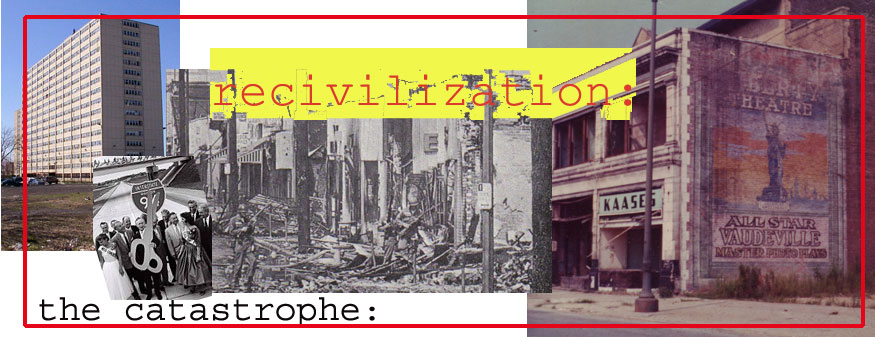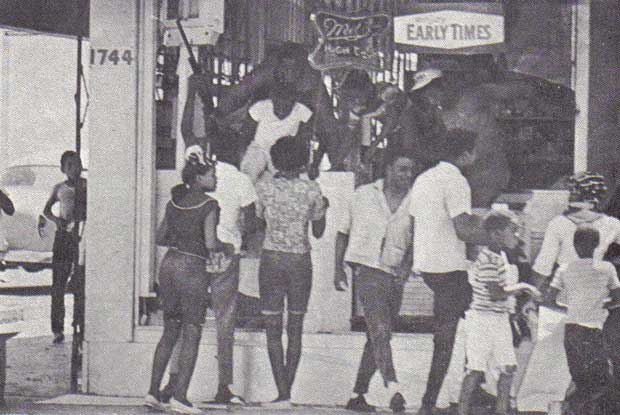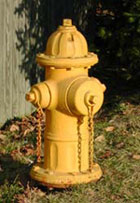

321 burn baby burn
Watts, 1965
The protracted agony of the riots began in 1964, only a year after Dr. King's great speech before 200,000 integrated marchers on the Capitol Mall seemed to point the way to a new national consensus for equality and brotherhood. While Congress was debating the Civil Rights Act, disturbances occurred first in Harlem and Brooklyn, then Rochester, Paterson, Jersey City and Elizabeth. In the summer of '65, Chicago's West Side went up, along with Watts in Los Angeles-the first riot to be covered on live television, in a city recently praised in an Urban League study as having the best quality of life for blacks. Watts at the time had the highest rate of homeownership of any black neighborhood in the U.S. The year 1967 marked the crest of the wave, with major riots in Detroit, Newark and Cleveland, and many smaller ones in other cities. Detroit's inferno started on a hot July night in '67; after three days, 43 were dead, and 2,509 buildings looted and burned, in the most spectacularly destructive riot in American history. It happened in a city with a capable and sympathetic young liberal mayor, Jerome Cavanaugh, elected by Detroiters as the great hope for overcoming the hatred and troubles of their past. King had already marched in Detroit, in 1963—Mayor Cavanaugh invited him in, at the same time he was desegregating the police and fire departments, and scrounging millions in federal dollars to make Detroit a national model of what a city could do. In 1968, seven more cities went up on the night after King's assassination. The riots wound down after that, both in number and intensity, but the cities would never be the same again. They reacted in different ways: Cleveland and Gary elected the first black mayors since Reconstruction, Carl Stokes and Richard Hatcher, on the same night in 1967. In Detroit, attitudes hardened, and Cavanaugh's career was finished, while New York put its trust in a patrician liberal Republican, John Lindsay. In every city, though, white minds changed. The inner city seemed no longer to be theirs, and many decided to get out as fast as they could. Whites (and many blacks) wrote off the riot areas as permanent war zones. Shops that hadn't burned soon closed up, and for a long time there would be no thought of any new private investment. The 1968 Report of the National Advisory Commission on Civil Disorders, a best-seller in paperback, spent eighty pages detailing the causes of the 60's wave of riots, in a section entitled 'Why Did it Happen?' The Commission found many of the right answers, although perhaps more enlightening were the results of the attitude surveys it conducted in black neighborhoods. Twelve major grievances were enumerated, with the three of 'highest intensity' being police practices, unemployment and housing. Though police riots no longer occurred, at least outside the South and Daley's Chicago, everyday cop behavior was indeed a major part of the problem. Police may have tolerated or protected many things in the ghetto, but their treatment of black men makes the racial profiling of today seem positively innocent. Detroit's big riot started with a police raid on a 'blind pig', an illegal after-hours club, where a family party was underway to welcome two young Detroiters home from Vietnam. In many places urban renewal issues helped create the tension that led to riots, as in Newark, where the city was entertaining plans to demolish 150 acres in the heart of the black Central Ward for a medical college. Riots tended to occur not in the oldest slums of the ghetto or in the projects, but in areas that had more recently been packed full of more upwardly-mobile blacks and refugees from urban renewal and freeways. Many of them had seen a rapid, panicked racial turnover. In Cincinnati, it happened not in the ancient West End slums, but in the newly 'changed' Avondale area; in Cleveland, not in the old Central district, but in the new ghetto of Hough, on the edge of the University-Euclid urban renewal area. In Chicago, not on the south side, but the west side. In Atlanta, it was the west side Dixie Hill area, a mile west of the old ghetto. In Detroit, the 12th Street riot area fit the pattern closely: recent racial change through blockbusting, a high proportion of renters in overcrowded flats, and several thousand people displaced by urban renewal downtown. The connection should not be surprising; a panic left a neighborhood badly stressed, and those that did not have riots shared their fate in falling victim to rapid disinvestment and abandonment. The failure of whites, media and elites to understand what was happening was nearly total; some blamed it on communists or 'outside agitators', or on King and the other civil rights leaders. Lyndon Johnson, who set up the Kerner Commission to investigate the causes of the riots, believed there had been an organized conspiracy behind them. People just thought that way in the 60's, and many continued to do so even after the Commission showed them it wasn't so. Liberals held that desperation born of poverty was the cause, but the Commission put that idea to rest too. Its investigators noted with some bewilderment that 83% of the people arrested for looting in Detroit had jobs, and half of them belonged to the United Auto Workers. In the Washington riot, three fourths of those arrested were employed, many by the federal government. In a cursed decade when everyone else was behaving badly, or stupidly, blacks could hardly be exempt. Black nationalism, a mixture of extremist race pride and long-simmering disgust, became a force in the riot era. The nationalists were street fighters, veterans of the civil rights movement who had learned to use protests, sit-ins, bluffing and scare tactics to gain desegregation of downtown shops or equal treatment in the schools. Our picture of the civil rights movement focuses on the heroics of King and others in the south, to the almost total exclusion of the big events back up north: the open-housing marches, the school desegregation marches, the pickets and protests around city hall and the banks-not to mention what came to be called 'mau-mauing', as when a mob occupied the San Francisco mayor's office in 1967 to protest budget cuts (which were immediately rescinded), or when residents of the Shaw neighborhood in Washington collected crates full of rats in their neighborhood and threatened to drop them off in Georgetown, a highly publicized event that forced the city to put the rat men back to work in Shaw. Not all of the nationalists were so useful; a good many were simply pistol-worshipping thugs, drunk on a dramatic new ideal of black power. And even the more reasonable ones felt little but disdain for blacks who cherished such an old-fashioned ideal as trying to improve their neighborhoods. Already in the 60's, a Washington activist could dismiss the city's Federation of Civic Associations as a 'pasteurized, frightened black group of people who worry about street lights, garbage cans and good manners'. After the riots, many nationalists openly said they didn't want the burned-out white merchants trying to come back. One of them, a young man named Marion Barry who would gain some notoriety later on, took a more liberal approach, saying they could 'come back and give their experience and expertise—and then leave.' |
|

|